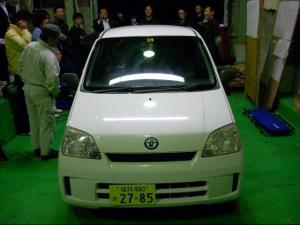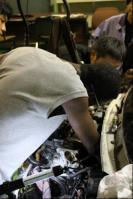| Owner | Gary Payton |
|---|---|
| Owner's Other EV | Rat Pack |
| Location | Seattle, Washington United States map |
| Web/Email | WebPage |
| Vehicle | 2002 Daihatsu Mira This is a Japanese Daihatsu Mira kei car conversion I helped lead for Fukui Byora, a company that makes all sorts of metal parts that you surely have in your house somewhere inside stuff you use. I spec'd it and procured the parts. It's an 8.6 KWH battery pack with an AC motor going through the clutch to the original manual transmission. The guys in our company did the design, machining, and installation of the adapter system. It's pretty elaborate and very well made. We all worked on the actual build of the car. As you can probably guess, we did this conversion in Japan and just finished it last week as this posting. |
| Motor | HPEVS AC 15 3-Phase AC 43kw |
| Drivetrain | AC motor mated to stock manual 5 speed |
| Controller | Curtis |
| Batteries | 48, 3.30 Volt, Lithium Iron Phosphate Got these from Elite Power Systems. Came with a BMS but we decided it was too much trouble for now. Others have had success without them so we're experimenting. It's really 2 small 60AH 72V packs we had to rearrange into a 120AH 72V pack. |
| System Voltage | 72 Volts |
| Heater | Electric |
| DC/DC Converter | Kelly Just an inexpensive Chinese setup |
| Instrumentation | rpm, charge, speedometer |
| Top Speed | 90 MPH (144 KPH) |
| Acceleration | Not measured, should be much better than original 660cc engine. Motor's torque is 2x the engine's!!! |
| Range | 60 Miles (96 Kilometers) We guess 60 miles if you're not a lead foot and hills don't eat your energy. |
| Watt Hours/Mile | Not measured |
| Seating Capacity | 4 in a pinch. Would be better if the font seats had been installed in the original for-aft position. |
| Curb Weight | 1,500 Pounds (681 Kilograms) There are lots of little places were we could have saved lots of weight but it's a first build so... |
| Tires | 13" narrow Yokohama eco-tires |
| Conversion Time | 8 months |
| Conversion Cost | $15K excluding labor |
| This isn't my personal car. It belongs to Fukui Byora, the company. I proposed an EV club and they basically said "why not?" They'll use it as a company car once the rear springs are beefed up and a secondary restraint is added to keep the battery from flying forward in case of an accident. I just helped lead the team, specified the parts, procured them, and helped tear down and rebuild the car. The most troublesome part was taking out the heater box to put the electric heating element in. We literally had to take the whole dash board, cross beam, and steering linkage loose along with all sorts of wires and other parts attached. LOTS of trouble there. In the future, I'll just use a fluid heater and a reservoir... Or just build a kit car. A trick we used for the steering was to drain the power steering fluid from the rack and just plug the input and output. It yields something about 80% as good as a proper manual steering rack. In our test runs the car worked quite well, even with 4 people and climbing a reasonably steep grade. | |
Copyright © 1997-2025 by Mike Chancey






